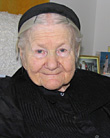The Courageous Heart of Irena Sendler
Saturday, April 11, 7:30 PM
Sunday, April 12, 5:00 PM
Krannert Auditorium, Purdue University
The story of Irena Sendler, a social worker who was part of the Polish underground during World War II and was arrested by the Nazis for saving the lives of nearly 2,500 Jewish children by smuggling them out of the Warsaw ghetto.
"There are two kinds of people: good and bad. Nationality, race, and religion do not play any role; what is important is which human you are." -- Irena Sendler
About the Film
The story of Irena Sendler is one of the most remarkable—and most unlikely—heroes of World War II, saving 2500 Jewish children during the German occupation of Poland. As a social worker, Irena had access to the Warsaw Ghetto, making it possible for her to rescue the daughter of a Jewish friend and safely hide the young girl with a Catholic family. Realizing that thousands of children were still in danger, Irena recruited sympathetic friends and co-workers to smuggle children out and place them in safe homes, farms and convents. At great personal risk, she devised extraordinary schemes to sneak the children by Nazi guards, bringing them out in ambulances, suitcases and even wheelbarrows. Irena was eventually captured by the Gestapo. Even after months of torture, she maintained her silence. Her heroic efforts were honored by a nomination for the Nobel Peace Prize in 2007.
About Irena Sendler
 Irena Sendler (Krzyzanowska), a Roman Catholic, was born in 1910, in Warsaw, Poland, and grew up in the town of Otwock. Her father, a physician, died from typhus that he contracted during an epidemic in 1917. He was the only doctor in his town of Otwock who would treat the poor, mostly Jewish community of this tragic disease. As he was dying, he told 7-year-old Irena, "If you see someone drowning you must try to rescue them, even if you cannot swim."
Irena Sendler (Krzyzanowska), a Roman Catholic, was born in 1910, in Warsaw, Poland, and grew up in the town of Otwock. Her father, a physician, died from typhus that he contracted during an epidemic in 1917. He was the only doctor in his town of Otwock who would treat the poor, mostly Jewish community of this tragic disease. As he was dying, he told 7-year-old Irena, "If you see someone drowning you must try to rescue them, even if you cannot swim."
When World War II started in 1939, Irena worked as a social services director in Warsaw. She would make false documents for Jews in the city and had already started gathering her rescue network of about 30 volunteers. When the Warsaw Ghetto was erected in 1940, Irena saw the danger ahead. When liquidation started in 1942, Irena and her network accelerated the rescue process. About 800 were taken from the Warsaw Ghetto, many of which were orphans. Approximately the same number were in orphanages and convents, Irena and her network assisted in the hiding of these children. She kept the only record of their true identities in jars buried beneath an apple tree in a neighbor's back yard, across the street from German barracks.
While working with the underground organization, Zegota, Irena and her network would assist in the hiding of about 900 children and many adults in homes around the city. Irena was caught by the Gestapo and almost killed in 1943. She escaped Pawiak prison and stayed in hiding for most of the rest of the war.
After the war she dug up the jars and used the notes to track down the 2,500 children she placed with adoptive families and to reunite them with relatives scattered across Europe. But most lost their families during the Holocaust in Nazi death camps.
In 1965, Mrs. Sendler became one of the first of the so-called righteous gentiles honored by the Yad Vashem Holocaust memorial in Jerusalem. Poland’s Communist leaders did not allow her to travel to Israel; she was presented the award in 1983. In 1991 she was made an honorary citizen of Israel. In 2003 she was awarded Poland's highest distinction, the Order of White Eagle.
Irena passed on in 2008 at the age of 98.
Jewish Virtual Library Website
Wikipedia
New York Times Obituary
Additional Reading
Irena Sendler: Mother of the Children of the Holocaust
ISBN: 0313385939
Publisher: Praeger Publishers
View summary and and purchase reading at Goodreads